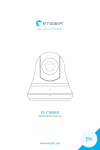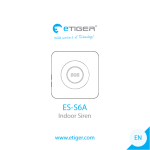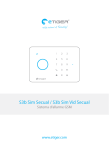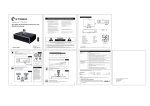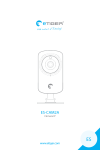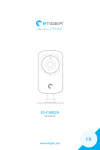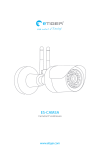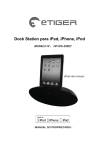Download "user manual"
Transcript
14 60 4 EN TEST ALARM ES-D5A Wireless Smoke Detector www.etiger.com - - - - - - - - - - - - - EN Specifications Power Supply: 9V battery Current (stand-by): ≤10 uA Operating current: ≤40 mA Smoke sensitivity: Grade II Frequency: 315 MHz / 433 MHz Transmission distance: ≥120 m (in open area) Operating temperature: -10°C ~ +50°C Volume: ≥75dB Dimensions: 107 x 44 mm Battery life: ≥1 year European standard: EN 14604-2005 Model: PA-427 Reference: ES-D5A Box Content - - - - Smoke detector x1 Mounting bracket x1 User manual x1 9V battery x1 Design TEST LED indicator Test button ALARM Introduction This photoelectric smoke detector is designed to detect smoke anywhere the detector is installed. It does not detect gas, heat or flames. This smoke detector is designed to inform you in case of start of fire thanks to its built-in siren. It enables you to save precious time and evacuate your house before the fire spreads. However, this smoke detector can only send an alert if located, installed, and taken care of according to the instructions in this user manual. Installation Smoke detectors must be installed according to the European standard CE EN 14604. For a complete coverage of your home, the detectors must be installed in every room, storage area, cellar, attic and corridor. The minimum number of detectors to be installed is one on each floor, one in every bedroom and one in the attic. Useful indications: - Install one detector in every corridor next a bedroom room, as shown in figure 1. In homes with two bedrooms, it is necessary to install two detectors, as shown in figure 2. Dining room Kitchen Bathroom Living room - If your house or apartment has several floors, install a detector on each floor, as shown in figure 3. Toilets Bedroom Bedroom Bedroom Smoke detectors for basic safety Smoke detectors for optimal safety Ground floor Figure 1 Locations of smoke detectors in individual houses with one bedroom Toilets Kitchen Garage Smoke detectors for basic safety Figure 3 Locations of smoke detectors in a mutli-floor house Dining room Bedroom Bedroom Smoke detectors for basic safety Smoke detectors for optimal safety Kitchen Cellar Bathroom Living room Bedroom Figure 2 Locations of smoke detectors in single-floor houses with several bedrooms Optimal installation We recommend a complete coverage and the use of additional smoke detectors. - Install a minimum of two smoke detector for any type of home - Install a detector in every bedroom - Install a smoke detector at each end of a corridor giving access to bedrooms, if this corridor is more than 12-meter long - Install a detector in every room with a door that can be used as a bedroom: smoke might be blocked by the door and the siren in the corridor might not be loud enough to wake the person up if the door is closed. - In the cellar, install the detectors near the stairs - On the second floor, install a detector at the top of the stairwell leading from the first to the second floor. - Make sure no door nor any obstacle will prevent the smoke from reaching the detector - Install additional detectors in your living room, your dining room, in the common area, the attic and in the storage areas or in the laundry room - Install the smoke detectors as close as possible to the center of the ceiling. If it is not possible, install the detector at the ceiling, minimum 10 cm from the wall, as shown in figure 4. Ceiling Never here 1m Horizontal distance from the top of the ceiling 10 cm minimum Center of the ceiling Detector 10 cm maximum 15 cm Smoke detectors for basic safety Figure 5 Recommended location for an installation under a sloped ceiling Warning: unsuitable installation Optimal location Acceptable location Figure 4 Optimal and acceptable locations for smoke detectors - If you cannot install the detector at the ceiling and wall-mount is authorized by the laws in your country, install the detectors 10 to 15 cm from the ceiling as shown in figure 4. - If you have no choice but installing the detector on a sloped ceiling, try to install the detector at a horizontal distance of 1 m from the top of the ceiling, as shown in figure 5. False alarms occur when the smoke detectors are installed in locations where their use may be obstructed. In order to prevent false alarms, do not install smoke detectors in the following situations: - In or near locations exposed to combustion particles, such as kitchens with few windows or insufficient ventilation, garages exposed to exhaust fumes, near furnaces, hot water heaters, and space heaters. Do not install smoke detectors less than 6 meters away from places where combustion particles are usually present like kitchens. If the 6-meter distance cannot be respected, e.g. in a mobile home, try to install the detector as far from the combustion particles as possible, preferably on the wall. In order to prevent false alarms, make sure these locations are well ventilated. Important Never deactivate the detector to prevent false alarms. - Figure 6 highlights usual air streams circulating inside a kitchen and the way potential combustion particles can reach the detector, emphasizing the recommended and nonrecommended locations to install the detector. - In stagnant air areas. Stagnant air areas are often at the top of a peaked roof, or in the corners between ceilings and walls. Stagnant air areas may prevent smoke from reaching the detector. Refer to figures 4 and 5 for recommended mounting locations. - In damp areas or near bathrooms with showers, the moisture present in humid air may enter the smoke chamber and turn into droplets when cooling, which may cause false alarms. Install smoke detectors at least 3 meters away from bathrooms. - In insect-infested areas as insects entering the detector’s smoke chamber may cause a false alarm. Where bugs are a problem, get rid of them before putting up a detector. - In very cold or very hot areas, including unheated buildings or outdoor rooms. If the temperature goes above or below the operating range of the smoke detector, the latter will not work properly. The operating temperature range for your smoke detector is -10°C to 50°C. - In very dusty or dirty areas, dirt and dust may accumulate in the smoke chamber and make the detector over-sensitive. Dust or dirt may also block openings of the smoke chamber. Do not install the detector near fresh air vents or in very drafty areas (next to air conditioners, heaters or fans) as it may prevent smokes from reaching the smoke detector. Air feedback Air intake - Near fluorescent lights, electrical noise from fluorescent lights may cause false alarms. Install the smoke detector at least 1.5 meter from such lights. Warning Never remove batteries to prevent false alarms. In case of alarm, open a window or shuffle the air around the detector to help evacuating the smoke from the detector. The alarm will turn off once the smoke is gone. If false alarms persist, clean the detector according to the instructions in this user manual. Keep away from the detector when the alarm is ringing out. The alarm is loud enough to wake you up in case of emergency. Long-term exposure to the alarm may be harmful to your hearing. Bedroom Bathroom Mounting Make sure you have read carefully the instructions for optimal and unsuitable installations before mounting the detector. Kitchen Bedroom Living room Unsuitable installation Figure 6 Recommended smoke detector locations to avoid air streams with combustion particles Select a suitable location (generally speaking, place the detector at the center of the ceiling of the detection area) and screw the 86 x 86 mm mounting bracket to the selected location (see drawing on the next page). 115 Fastening 75 Base The detector is a small device that shall not be opened. Insert the battery in its compartment and turn the plastic cover clockwise. Press the test button and make sure the detector can work properly. Usage Register the detector in the alarm system Switch to Connection Mode on the control panel. Press the test button on the detector. The control panel beeps once: the detector is registered. If you hear two beeps, the detector has already been connected. Note For a continual protection of your home, the detector is assigned to the 24h zone as per default settings. In case of low battery, the detector will send a signal to the control panel. The detector is working: make sure the LED blinks once every 45 seconds. If so, the detector is in normal detection mode. When the smoke detector triggers an alarm, the alarm will not stop until the air is smoke-free again. Operating test Press the test button on the smoke detector. The detector rings out, the LED indicator blinks fast and sends a signal to the alarm system. Also test the detector by exposing it to smoke. To make sure the detector is working properly, it is recommend to run this test once every six months. Care It is recommended to open the cover and remove the dust in the detector’s smoke chamber at least once a year. Remove the battery before cleaning the detector. Remove the dust with a vacuum cleaner (attached to a soft brush). Carefully remove dust in the detector components, especially in the openings of the smoke chamber. Hand-wash the cover with a cloth dampened with clean water and dry it with a lint-free cloth. Do not let any water in the detector components. Once your detector is clean, replace the battery, and close the cover. Test detector after cleaning. Standards This product bears the selective sorting symbol for waste electrical and electronic equipment (WEEE). This means that this product must be handled pursuant to European Directive 2002/96/ EC in order to be recycled or dismantled to minimize its impact on the environment. For further information, please contact your local or regional authorities. Electronic products not included in the selective sorting process are potentially dangerous for the environment and human health due to the presence of hazardous substances. In compliance with European laws. This product was designed and manufactured in compliance with Directive 2002/95/EC of the European Parliament and of the Council on the restriction of use of certain hazardous substances in electrical and electronic equipment (RoHS Directive - RoHS) and is deemed to comply with the maximum concentration values set by the European Technical Adaptation Committee (TAC). Manufactured in China. ES-D5A–UM-EN20140728-1.0 This user manual is available in other languages at www.etiger.com/eu/support ETIGER EUROPE Rue de la Loi, 25, 7100 La Louvière, Belgique [email protected]








